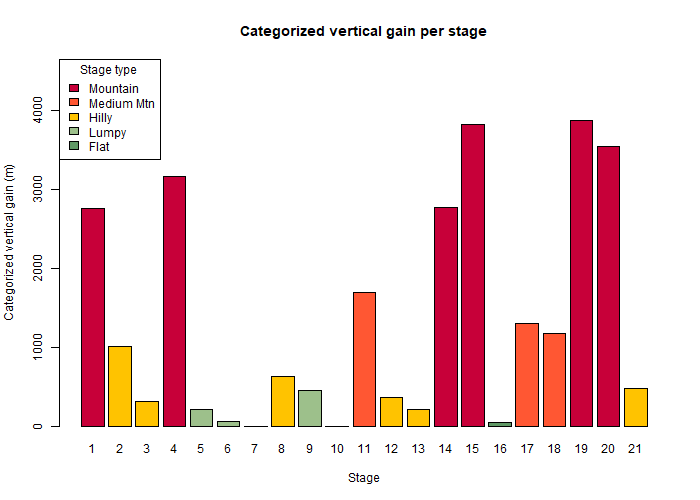Climbing in the 2024 Tour de France
By Mikkel-T ([email protected])
Posted on Jun 28, 2024
Contents
Intro
The Tour de France is just around the corner, and at sanluca.cc, we can't wait. For the past month, we have been hard at work uploading routes and creating fun and interesting graphics about Le Tour, and all info about the race can be found right here.
This year, the Tour de France starts in Italy with quite a hard stage climbing-wise, and already on stage 4, the Galibier will be featured. We have decided to make an overview of the climbing in this year's tour that will hopefully be helpful.
Please note that this post only focuses on the climbing difficulty of the stages, and doesn't take the two ITTs and the gravel stage into account when discussing the route and the hardness of it.
The stages and their categories
21 stages, 3499 km and a total vertical gain of almost 48,000 meters are just some of the stats that the riders of the 2024 Tour de France can look forward to, with not many of the stages being completely flat. We have a script that gets run every time we add new routes to the website, one of the features of this script is to categorize routes into one of the following categories:
- Flat
- Lumpy
- Hilly
- Medium Mountain
- Mountain
For this Tour, most of the stages are in the final 3 categories, with only 6 stages being either flat or lumpy. The full overview can be seen here:
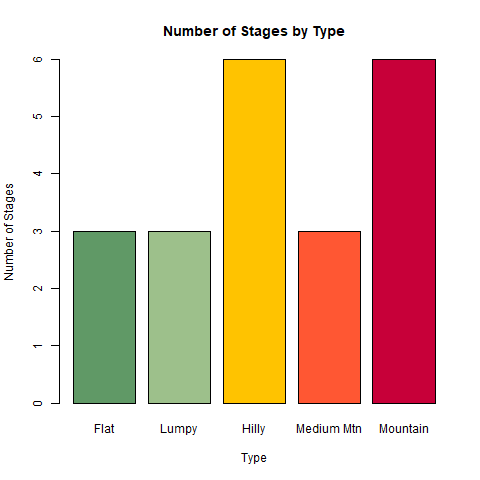
If you then look at the type of stage for the different weeks of the tour (stage 1-9, 10-15 and 16-21), you can see that many of the harder stages are concentrated in the last part of the tour.
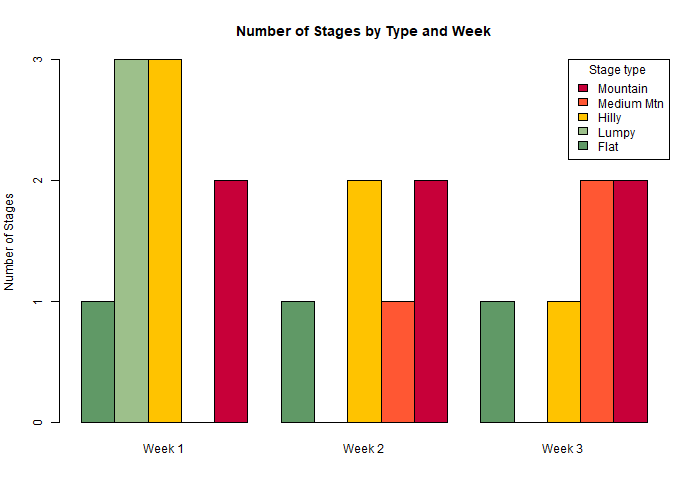
With the way the tour is built up you have to be ready from day one with the very first stage being a mountain stage, and the second stage featuring the San Luca two times. You will lose time if you are not 100% in the first week, but it might be possible to gain back in the last weeks with the amount of hard stages there.
Although our categorization can say much, the vertical gain per stage is also important. Therefore we have of course also prepared a graphic to show this for each stage with the color of the stage still being the category.
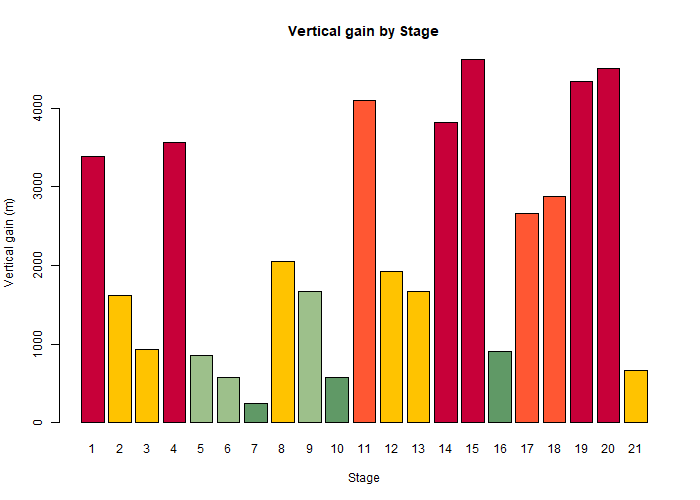
Both stage 19 and 20 finish uphill, up Isola 2000 and Col de la Couillole respectively, both categorized by ASO as a category 1. The final stage is an ITT from Monaco to Nice which is also hard, going up to La Turbie and over Col d'Éze. Definitely a part of the race where you can try to take back some important time on your competitors, and can't afford a bad day. Stage 17 has the potential for some GC fights while stage 18 mostly looks like a breakaway stage.
The categorized climbs
As always, ASO has categorized climbs along the route for the KOM competition. This year, there will be 67 categorized climbs with a total length of 438 km and vertical gain of almost 28,000 m. A list of all the categorized climbs can be found right here.
The longest climb will be the Sestrières on stage 4 with a length of 39.9 km while the shortest will be Côte de Tortone - Fausto Coppi on stage 3 with a length of just 1.1 km.
The steepest climb will be the Côte de Gallisterna on stage 2 with an average gradient of 11.4% while the least steep climb will be the Col de Manse on stage 18 with an average gradient of just 3.6%.
Meanwhile, the climb with the most vertical gain will be the Cime de la Bonette on stage 19 with a vertical gain of 1585 meters while the climb with the least vertical gain will be the Côte de Fambetou on stage 16 with just 58 meters of vertical gain.
The number of KOM's is shown on this graph:
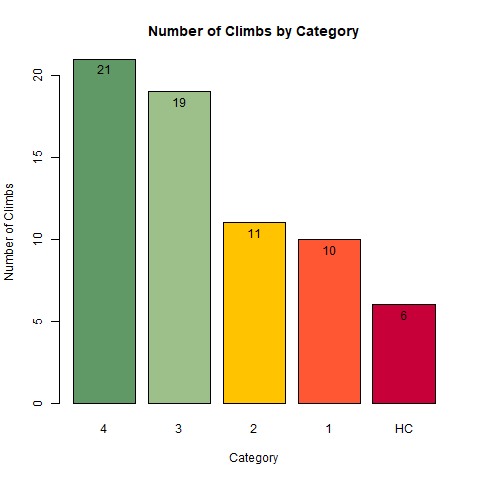
As you could have guessed, there are more climbs in the easier categories than in the harder ones.
Although this is the case, the HC climbs still account for around 25% of the total KOM length (110 km) while the cat. 4 climbs only account for around 10% (40.6 km).
| Cat | Length (km) | Vertical gain (m) |
|---|---|---|
| HC | 110 | 7290 |
| 1 | 103.5 | 7620 |
| 2 | 112.4 | 6175 |
| 3 | 71.7 | 4215 |
| 4 | 40.6 | 2200 |
Yet again, it is interesting to look at the number of climbs for each week of the tour, this could also be worth looking at in terms of the KOM competition.
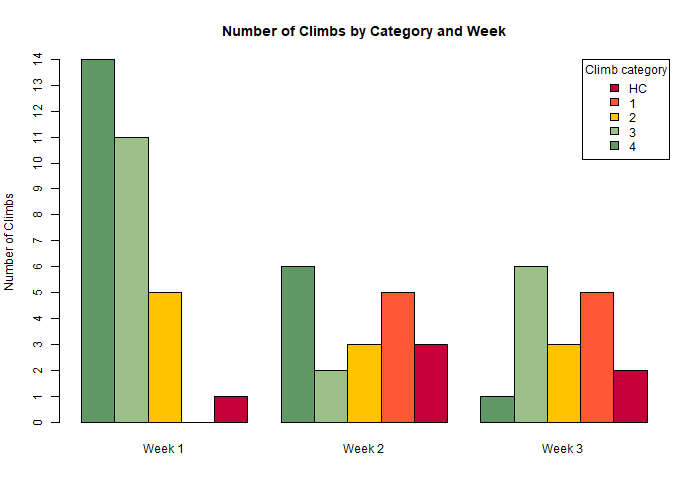
First of all, this again tells us that the first week is generally easier than the last two weeks, but also that it isn't vital for the battle of the KOM jersey (stage 4 is of course important with the Souvenir Henri Desgrange on top of the Galibier).
In conclusion, it looks like a hard but interesting version of the Tour de France. The first week is for the most part easy but with stages 1 and 4 to spice it up. Hopefully, the first couple of stages won't spoil the GC battle fully, and if it does we will hopefully see some awesome fights for the break and some of the mountain stages while also keeping GC tensions high together with the other competitions.
Extra graphics
Here are some extra graphics that didn't find their way into the blog post, but still are interesting.
Total length of the categorized climbs per stage
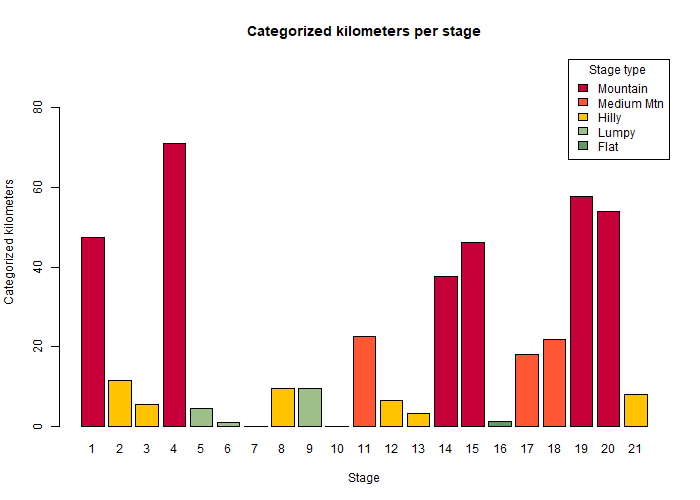
Total amount of vertical gain on the categorized climbs per stage
